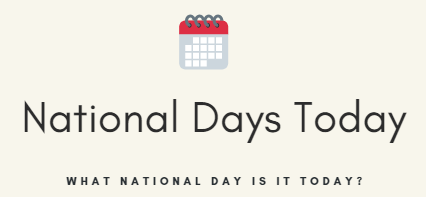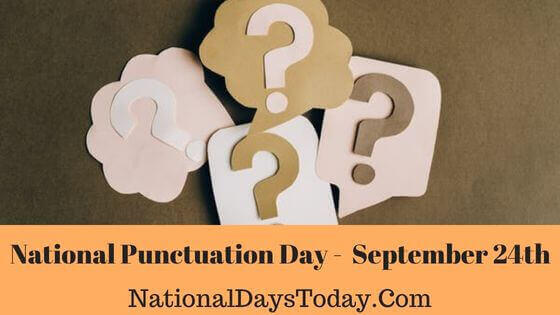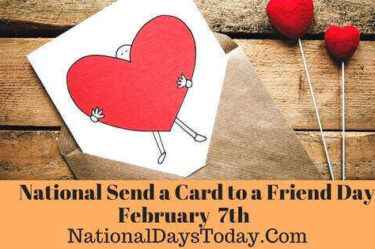National Punctuation Day
National Punctuation Day:
National Punctuation Day celebrates on September 24th. A comma, a punctuation mark, a period, an apostrophe, a semicolon question mark, and an exclamation mark are a few examples of punctuation styles employed in writing.
| Year | Date | Day | Where |
| 2023 | 24th September | Sunday | United States |
| 2023 | 24th September | Tuesday | United States |
| 2025 | 24th September | Wednesday | United States |
Twitter Hashtags:
#NationalPunctuationDay
#PunctuationDay
Related: Other National Days Celebrated on September 24th:
Why National Punctuation Day?
Punctuation is the usage of typographical symbols, spaces, and other mutually agreed symbols that aid in understanding written text. The principal purpose of punctuation is to communicate the proper meaning and intention the writer intends to convey in his text.
Each language has its own rules for punctuation and symbols. What conveys an idea in one language could transmit a different message in another language. For example, in Greek, it is used to indicate a question. In Greek, the semicolon (;) is used to signal a question; however, in English, it’s used to join two phrases that have related in their meaning. It can also be used to distinguish elements within an order, even though the series includes a comma, and to connect two sentences.
How Can We Observe National Punctuation Day?
What better method to celebrate punctuation than by making use of it. Look for new techniques to make your sentences more punctuated. Try some of these ideas:
- Spend time criticizing the mistakes of others. You can also take the time to make sure you correct your own.
- Find out the terms of your contracts regarding insurance or warranties are missing a comma and could be in your favor.
- To stay clear of punctuation, you can complete crosswords throughout the day. They don’t employ any punctuation.
- Make sure your email is error-free and forward it to everyone you know. You can create an email with only one mistake and challenge your friends to locate the error.
- Create a discussion on your opinion on the Oxford Comma Online. It could become as intense as the political debate.
- Try using all kinds of punctuation during the day.
- Make a collage or painting of your most cherished punctuation marks.
- Let us know what you think about the transformation of punctuation to emoticons.
- Make meatloaf, then shape the loaves into shapes for punctuation.
- Everyone makes mistakes (but not when it comes to meatloaf). While some of our mistakes are amusing, some can be expensive and affect relationships and the overall financial picture.
Practice proper punctuation and properly post it using #NationalPunctuationDay on social media.
Interesting Facts About National Punctuation Day:
The question mark is… A word?
As we now end our literary questions using an easy image, ‘?,’ those who used Latin wrote out the word “question” to signal the end of the question!
Are you aware of what#’ means?
It is possible that you have used the word “pound” or “hashtag’ (maybe depending on your age) but little did we know that the official name of the currency is “octothorpe.”
Punctuation isn’t something that has always existed.
Text in the early days of writing consisted of long strings of characters that were unbroken by punctuation marks or spaces.
There was an alphabet that included ampersands.
Hot right after that letter “z” ampersands was written by the alphabet “z and per se and’. Because of years of lazy pronunciation, ‘ and perse and’ came to be the word we use today – ampersand.
“@” doesn’t necessarily mean “at” everywhere
While we may call this an “at mark” (or simply an “at’ around the world, the meaning varies widely; for instance, in Israel, it’s possible to refer to it as a strudel or a strudel, and in Russia, the name is a ‘little dog’.
History of National Punctuation Day:
Paying attention to your p’s and q’s, making sure you’re crossing your t’s and p’s and crossing your i’s, and being aware of the difference between a colon and a semicolon were not essential to convey messages. Today, we are used to the tiny dots or slashes and spaces that can turn an unintelligible string of letters into an engaging tale; the ancient civilizations were forced to live with a lack of. Since most early languages were only verbal, punctuation wasn’t required.
The first known document that has punctuation marks is Mesha Stele from 900 B.C. The next civilization to create rudimentary punctuation was the Greeks around 200 B.C. While they previously wrote in scripture continua, a continuous string of text, uncolored with punctuation marks. However, they quickly began to use the punctuation system invented by Aristophanes, who was from Byzantium. It included a single punctuation mark placed in a different position to signal pauses during speeches.
Although the Greeks already used punctuation, it wasn’t until after the Bible was printed in mass that punctuation was introduced across other cultures. Bible printing became widespread between 400 to 800 A.D., and punctuation was essential to ensure that people who read the text out loud were aware of where to stop reading and put emphasis. The 1400s saw a major change occur with the advent of printing presses and the resulting need for more unifying punctuation rules.
Although punctuation as a whole system hasn’t been changed much in the past few decades, Marks and symbols have slowly lost and gained significance. The most significant change occurred in the latter half of the 20th century when the world-changing advent of computers. In the last few years, words like “#” and “@” acquired new meanings derived from technology! In addition, texting and chatting online requires a completely different, informal body of punctuation rules.


